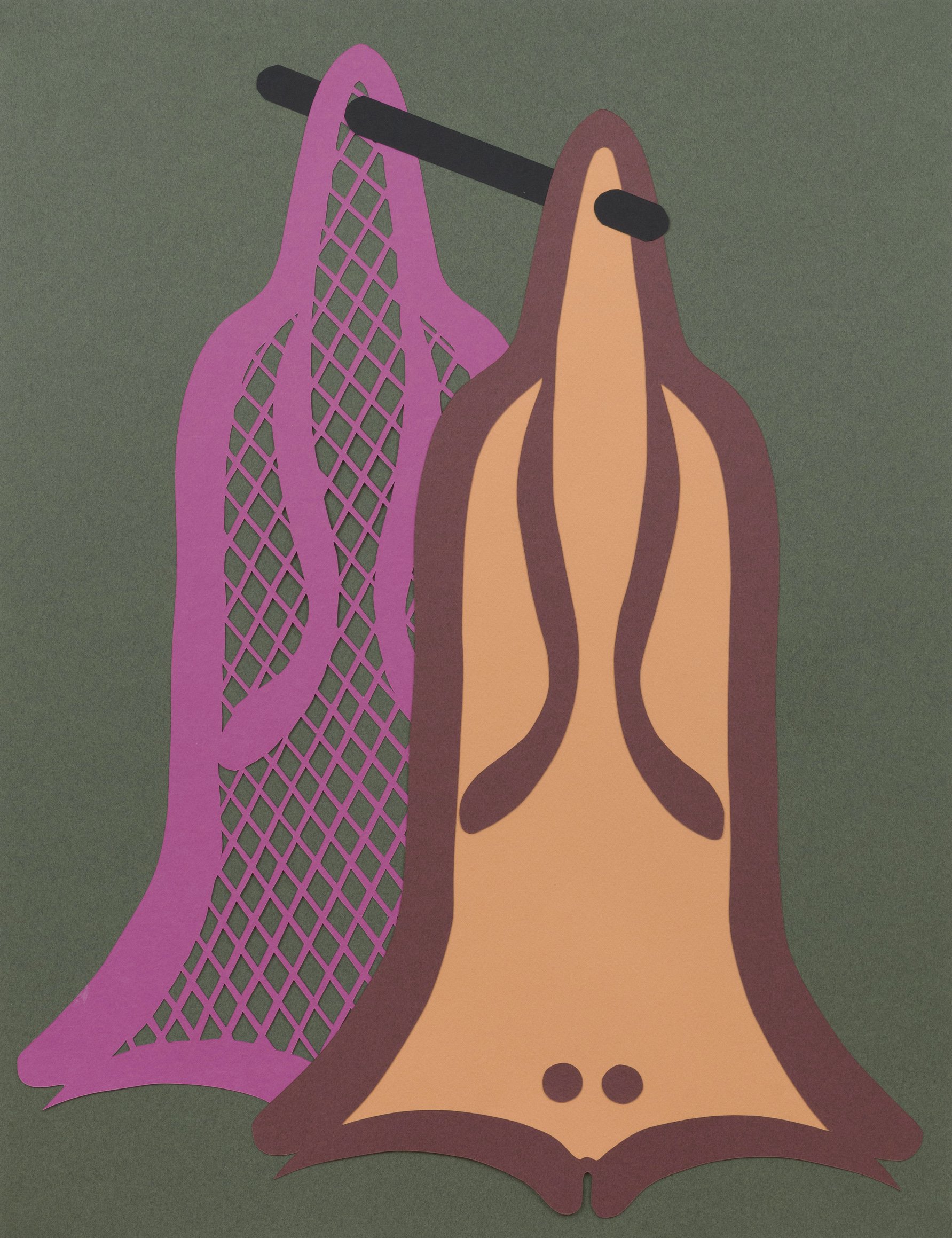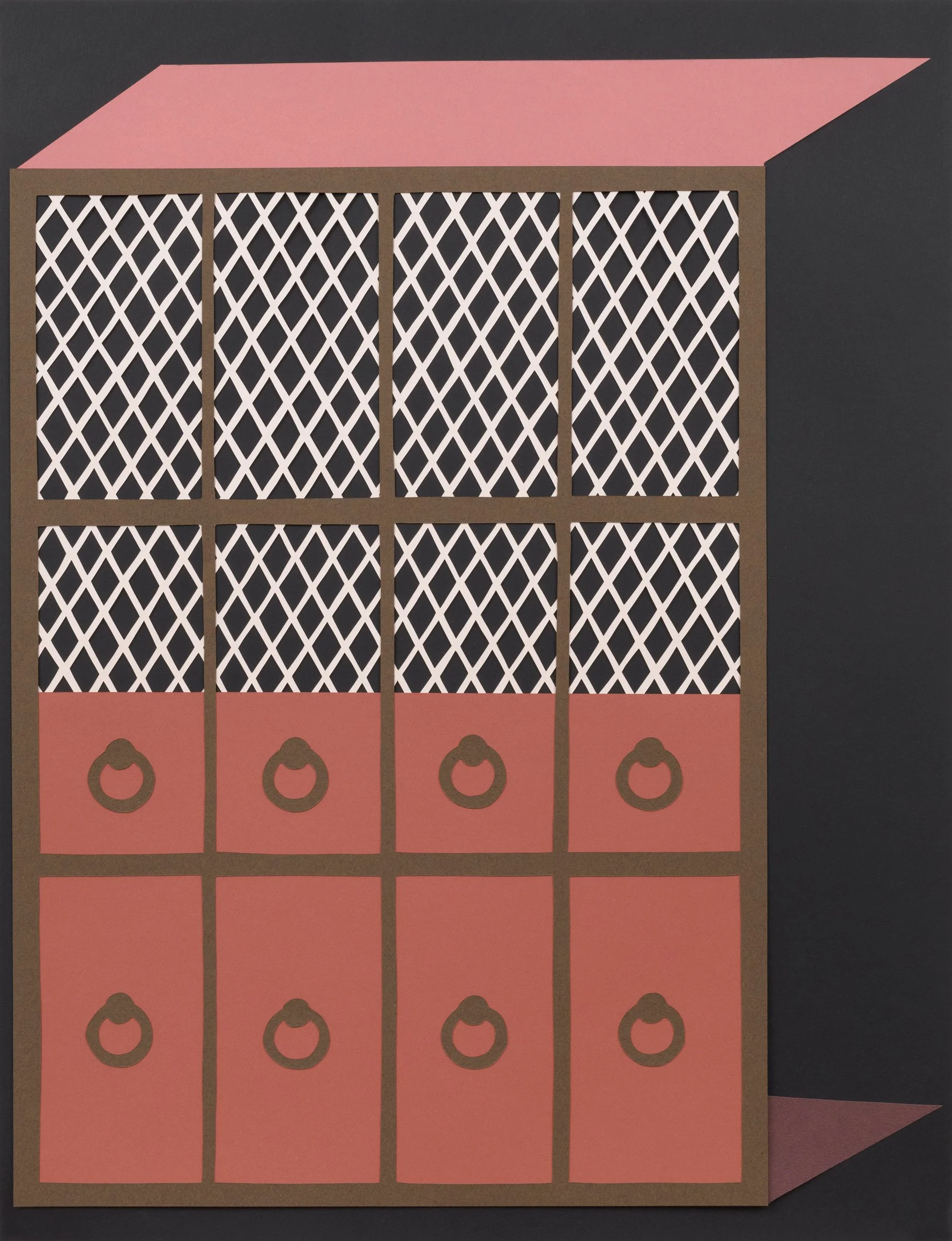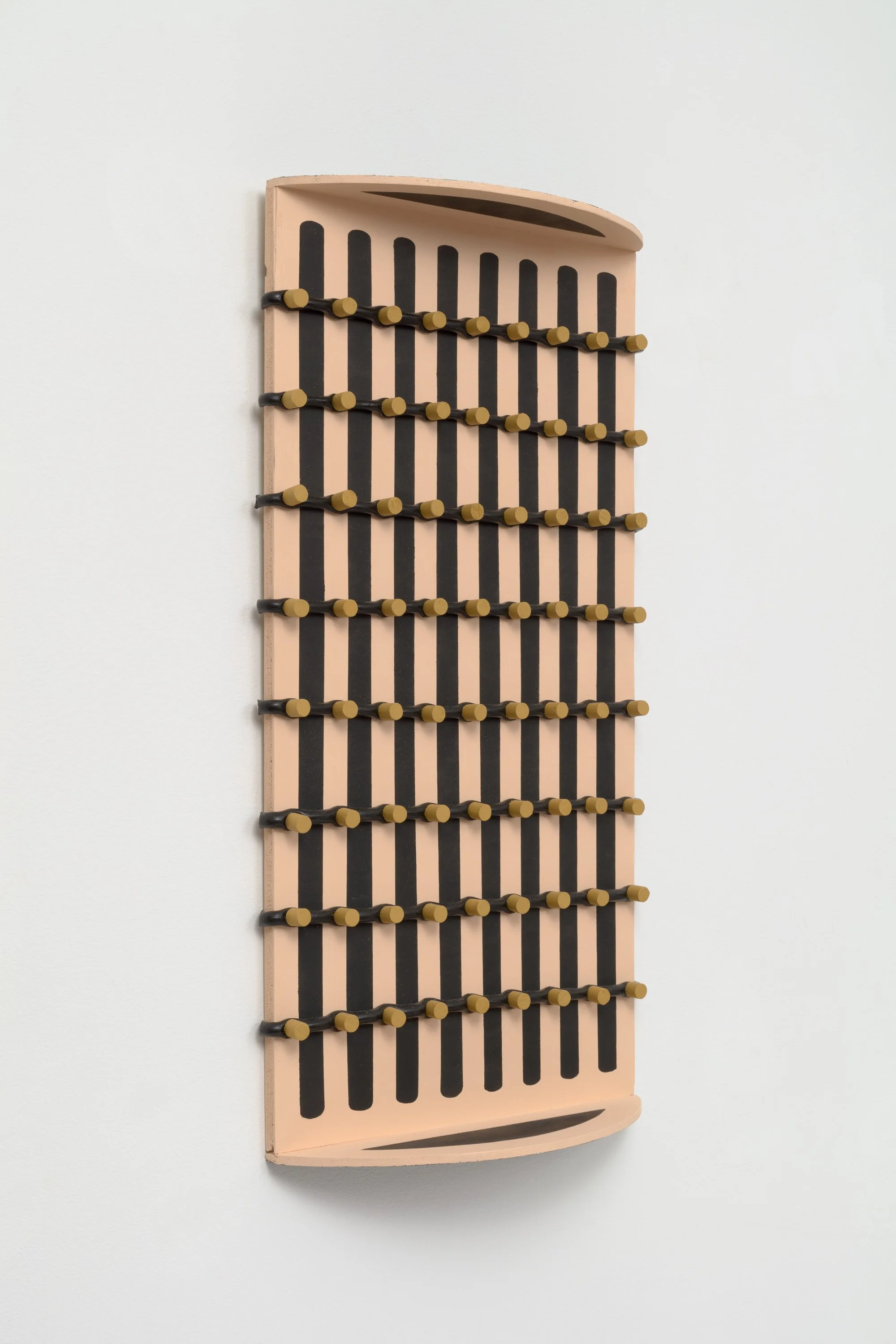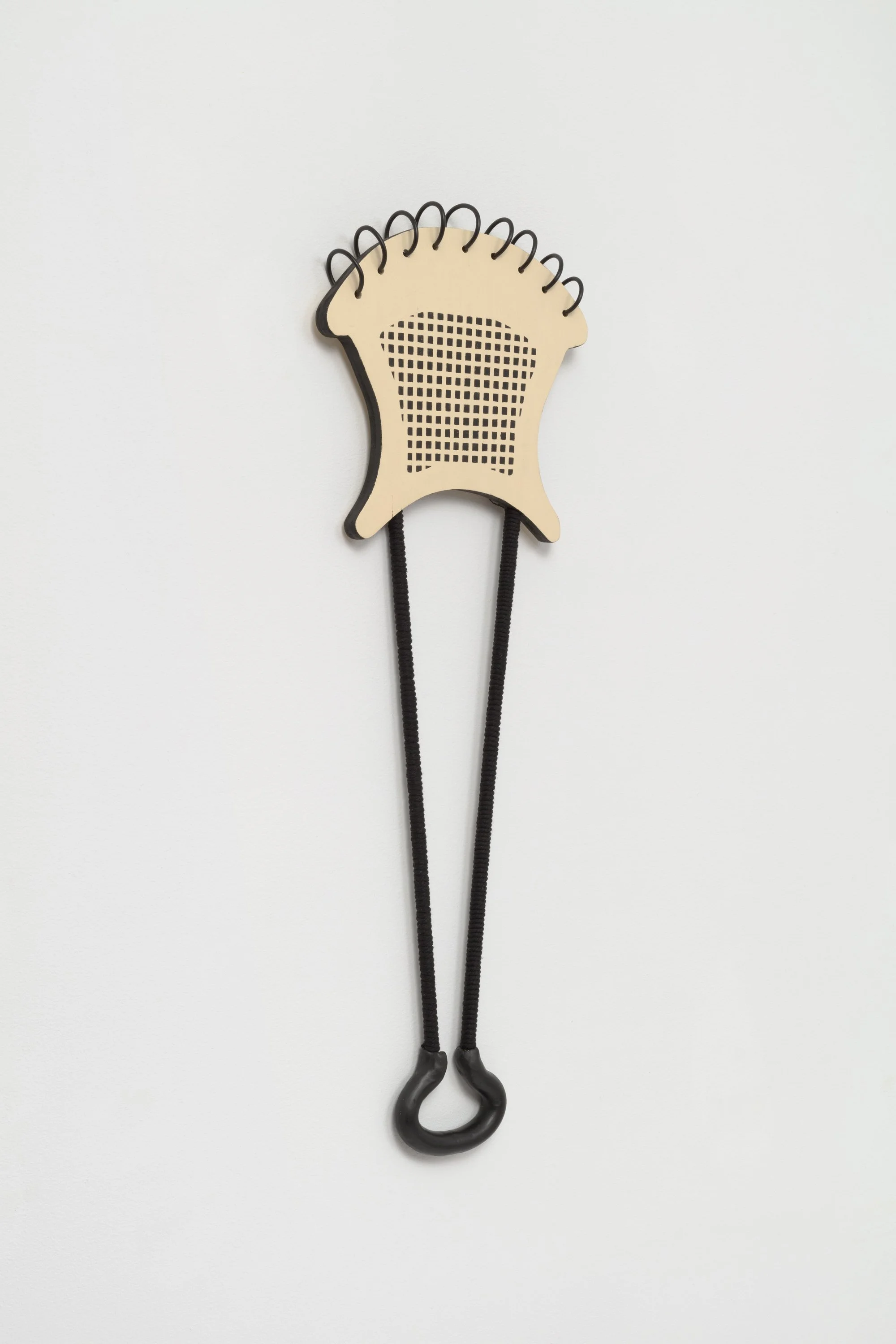Utility Suite (Double Bell), 2022. Papeer and adhesive. 25 x 19.5 inches.
Natalie Beall
BIO
With paper collage and mixed media wall sculpture, Natalie Beall (b. 1981, Atlanta, GA) invents new forms containing traces of functionality and fantasy. She earned her BFA from the University of Georgia and her MFA from Columbia University. Beall has participated in exhibitions at Fridman Gallery, Beacon, NY, Good Naked Gallery, New York, Standard Space, Sharon, CT, the Samuel Dorsky Museum of Art, New Paltz, NY, and the Wassaic Project, Wassaic, NY, among other venues. Residencies include the Saltonstall Foundation, Ithaca, NY, the Lighthouse Works, Fishers Island, NY, the Cooper Union, New York, NY, and the Lower East Side Printshop, New York, NY. The artist is a 2017 NYSCA/NYFA Fellow in Printmaking/Drawing/Book Arts. She lives and works in Salt Point, New York.
ARTIST STATEMENT
I create paper collages and mixed media wall sculptures of invented objects that hover between functionality and fantasy. Spare, symmetrical, and incorporating attributes of usefulness such as grids, hooks and holes, these forms contribute to a world of unnameable objects that move beyond function into a realm of wonder. These forms’ flattened, pared down states allude to their suspension between the everyday and the imagination. I seek inspiration in open-ended learning toys, ambiguous storage devices, and obsolete domestic implements. By using source imagery associated with the domestic domain, I embrace a lineage of traditionally undervalued pursuits that hold dormant potential.
My process is solitary and intuitive, so I use materials that I can manipulate in my home studio–wood, epoxy and foam clays, and assorted trimmings such as rope. In 2014, I also started working with cut paper to create two-dimensional versions of my sculptures. I recognized that together, these images create a lexicon of forms that has become my visual language.
Interview with Natalie Beall
Utility Suite (Curio), 2022. Paper and adhesive. 25 x 19.5 inches.
Can you tell us a bit about your background and how you became interested in becoming an artist?
I grew up in Atlanta, Georgia and always enjoyed making things, like wallets out of paper and staples. My maternal grandmother drew and painted in her spare time and gave me books about Grant Wood, Georgia O’Keefe and Degas, so I had some exposure to visual art early on. I also took art lessons in middle school from a man who made paintings of covered bridges on velvet. I hung out a lot in the darkroom in high school. I thought I might study art history in college, but when I started at the University of Georgia in 2000 I took a Freshman seminar on contemporary art and my whole world opened up. I learned about Kara Walker, Matthew Barney, Trenton Doyle Hancock, and many other major contemporary artists at the time, and I was a) incredibly energized about what art could be and b) realized that I wanted to go down the artist road, whatever that meant.
Can you tell us about some of your most memorable early influences?
I’m thinking about those Georgia O’Keefe books that I looked through as a kid, and I was really attracted to her stylized, somewhat surreal cloud paintings from the 50s and 60s. We would often visit the High Museum of Art in Atlanta, which has a sizeable folk art collection. Howard Finster’s paintings and sculptures from his art environment “Paradise Gardens” always captivated me. There’s both humor and reverence in his works that reference pop culture and Christianity simultaneously. I also grew up watching my mom sew and approach home decoration with complete gusto, which I didn’t really latch onto until later, but it was definitely an influence looking back.
Where are you currently based and what brought you there? Are there any aspects of this specific location or community that have inspired your work?
I’m currently based in a small hamlet called Salt Point in New York’s Hudson Valley. My husband and I moved here in 2016 after living in NYC for 12 years. In hindsight, we beat the COVID real estate rush, but we were mainly looking to carve out sustainable existences as artists, so we bought the house where we currently live and work. It’s a rural area with several dairy farms, so the culture is incredibly different from Brooklyn. It’s taken a while to find our footing in the Hudson Valley. The art community here is spread out but incredibly rich, and I’m grateful to be part of an artist group that meets regularly for studio visits. When I lived in the city, I would find inspiration in fanciful arrangements of trash that I’d encounter on the sidewalks. There’s none of that here, but there are a lot of antique and thrift stores and that’s where I’m currently finding a lot of inspiration.
Utility Suite (Linked, Hung and Strung), 2022. Paper and adhesive. 25 x 19.5 inches.
What is your studio space like? What makes your space unique to you?
My studio space is a 200 square foot bedroom in my house. It’s fairly humble as artists’ studios go, but it works for me. I have a 5 year old, so being able to work from home is key. I do woodworking in the basement. I have dreams of renovating our walk up attic to expand my studio.
What is a typical day like? If you don't have a typical day, what is an ideal day?
A typical day involves lots of multitasking–shifting between making, studio administration, domestic and caregiving work. When it’s time to really focus, I usually turn off my phone or put it in another room while I’m working. I’ll also disable Instagram temporarily. If I’m conceiving of something and working out a composition or form, I typically work in silence. When I need to cut patterns or work repetitively, I’ll put on a podcast like Pep Talks for Artists. An ideal day would look more like a residency: get up, exercise, into the studio, and someone else makes the meals.
What gets you in a creative groove or flow? Is there anything that interrupts your creative energy?
Making work begets more work. I often need to remind myself of this. Too much ruminating can prevent the making, so sometimes I just force myself to start and the flow kicks in. The stuff of life constantly interrupts: groceries, school pickups, random sick days, my cat scratching at the door.
How do you maintain momentum in your practice?
I set aside certain days for the studio and add them to my family’s shared calendar. If it’s a particularly difficult week, even just an hour a day can help sustain momentum. I also respond very well to deadlines. If I’m really feeling motivated I’ll go back into the studio after my son’s bedtime.
What medium/media are you working in right now? What draws you to this particular material or method?
I’m working both in cut paper collage and mixed media wall sculpture (painted wood and epoxy clay are my two primary sculptural materials right now). I first started collaging colored papers on a residency in 2014, after seeing Henri Matisse: The Cut Outs at MoMA. I wanted to start a parallel practice to my sculpture where I could work out forms in two dimensions. I haven’t stopped since–it’s freeing to work with a limited set of materials, it’s a clean process so very easy to set up in my home studio, and it’s also a way to create images that can function as a lexicon of my formal language. My sculptural process is more mysterious and can sometimes be more challenging, which keeps me intrigued. I sketch ideas before I start to make them, but inevitably working with materials that respond to gravity will force me to improvise. This is usually the interesting part. In the past I worked more with fabric, but I’ve been drawn to wood over the past couple of years for its reference to furniture and other domestic objects that inform my work.
Twisting Board, 2022. Wood, foam clay, acrylic paint. 29 x 18 x 0.5 inches.
Can you walk us through your overall process in making your current work? Does drawing play a role in your process?
I make quick preliminary drawings for both collages and sculptures, often based on photographs of objects I take on my phone. I’ll explore several variations on a theme before settling on a direction. In all media, I start by creating a large shape or shapes to which I add details, like gridded vents, connection points, hooks, holes, and other particulars that add to a sense of the object being mysteriously functional.
What is exciting about your process currently?
Inventing new forms–the images and objects that I want to see in the world–is incredibly exciting. I’m looking for the moment when a piece hits a sweet spot between being somehow both recognizable and unidentifiable.
Can you talk about some of the ongoing interests, imagery, and concepts that have informed your process and body of work over time? How do you anticipate your work progressing in the future?
I have an abiding interest in the quiet energy that objects contain, particularly in domestic spaces. In my research I look for objects that spark curiosity and hold latent energy, and I try to create that feeling in my work. Embedded within this fascination with objects is an interest in domestic space as the historical place where women have worked and created. For me, the question “How can objects transcend their traditional roles” is linked to “How can domestic labor transcend the constraints of supporting others?” I use objects to play with this idea of utility and often create objects that contain open-ended potential. None of the things I’m creating are truly functional, so there’s a refusal to be useful in any way that benefits the system economically. This can sometimes result in a disconnect between something that seems like it should perform a particular function but doesn’t. I see this disconnect and the feelings it might bring up (humor, frustration, intrigue) as equally valid ways to engage with the work.
My interest in domesticity became so much more real when I moved to a house in 2016 and had my child in 2017. I was embodying this character I had previously imagined of a woman alone in her home making strange objects for no practical purpose, and on top of that, struggling to adjust to motherhood. During COVID I became more interested in the work of children’s play, since I was setting up all manner of homemade activities for my son, and I began to look at learning toys like geoboards which then ended up in my work, for example in a piece called “Twisting Board”.
In the future, I see myself continuing to grow sculpturally. I’ve only been working with wood for about two years now, so I’m continually excited by the process of learning through the materials.
Fixing Tray, 2022. Acrylic on wood and epoxy clay. 24.5 x 12 x 3.5 inches.
Do you pursue any collaborations, projects, or careers in addition to your studio practice? If so, can you tell us more about those projects, and are there connections between your studio practice and these endeavors?
I have worked part-time in art education for over fifteen years. I have taught art in public schools and community centers through a few different nonprofits. For the past eight years I have worked in museum education at the American Folk Art Museum in New York City. Works from the museum’s collection have definitely influenced my own, like Shaker furniture and graphic quilts made by Amish women and the women of Gee’s Bend, Alabama. They have this incredibly elegant washboard carved out of marble on view that I’m really connecting with right now.
Have you had any epiphanies recently that have changed the course of your work or caused you to shift directions?
This isn’t recent, but in graduate school I shifted from drawing to installation. In some ways this was inevitable–I’d never had a real studio before so all of a sudden, I could fill a space. I also think that shift had to do with the many conversations that were happening in the studio and all of the new influences I was absorbing. I really pushed myself into a new way of working. After grad school, I found that making installations as part of a regular studio practice didn’t work for me, so I shifted to making stand-alone wall works that, while individual, could also be seen as part of a whole. I have continued in that vein ever since.
Can you share some of your recent influences? Are there specific works—from visual art, literature, film, or music—that are important to you?
I’ve been looking at Harmony Hammond’s work recently. Her ladder sculptures and grommeted and laced pieces really speak to me. I also recently read Everything She Touched: The Life of Ruth Asawa by Marilyn Chase. I am so impressed with the way Asawa combined artmaking, mothering, and community building. Finally, I just finished Everything Else is Bric-a-Brac: Notes on Home by Akiko Busch, which is a collection of short meditations on domesticity.
Who are some contemporary artists you’re excited about? What are the best exhibitions you’ve seen in recent memory and why do they stand out?
Rebecca Shore’s paintings and Diane Simpson’s sculptures are big inspirations.
With Pleasure: Pattern and Decoration in American Art 1972–1985 presented at the Hessel Museum at Bard College in 2021 was a standout exhibition featuring works by several artists I admire who embraced overtly feminine and domestic themes, including Ree Morton, Faith Ringgold, and Barbara Zucker. I didn’t have to travel very far from home to see it either, which is always nice.
The Meret Oppenheim exhibition at MoMA and the Nellie Mae Rowe exhibition at the Brooklyn Museum were revelations. I also really enjoyed the exhibition Arlene Shechet curated at Pace, STUFF.
Whip and Sieve, 2022. Acrylic on wood, with rope, epoxy clay and rubber coated wire. 25 x 8.5 x 1.5 inches.
Do you have any tips or advice that someone has shared with you that you have found particularly helpful?
I took a professional practice course in graduate school that was taught by the fabulous Jackie Battenfield, painter and author of The Artist’s Guide. I remember her saying that being an artist was a long game, and something about “last man standing”. Now that I’m in my early 40s, I understand that being an artist isn’t about some mythical “make it big moment”, it’s a process of continually showing up, pushing oneself creatively and professionally, and connecting with community. Defining my own meaning of success has been incredibly important.
What are you working on in the studio right now? What’s coming up next for you?
As I’m writing this, I have a solo show up right now at Morgan Lehman Gallery in New York titled “Pastimes”, which closes April 8. I just started working on some new sculptures which is always an exciting process. I’m looking forward to some summer group shows, so stay tuned for the details.
To find out more about Natalie Beall check out her Instagram and website.






